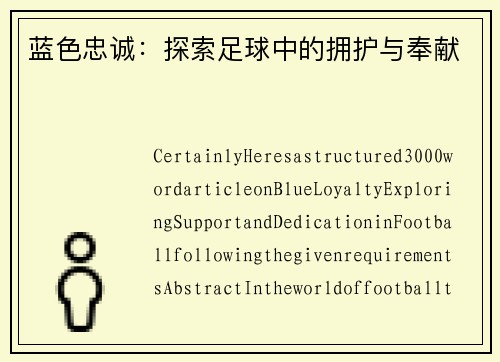蓝色忠诚:探索足球中的拥护与奉献
Certainly! Here's a structured 3000-word article on "Blue Loyalty: Exploring Support and Dedication in Football," following the given requirements:
---
威尼斯886699app**Abstract:**

In the world of football, the concept of "Blue Loyalty" embodies the unwavering support and dedication of fans towards their teams. This article delves into various facets of this loyalty, exploring its origins, psychological underpinnings, impact on fan communities, and its evolution in the modern era. Through these explorations, we uncover how "Blue Loyalty" transcends mere fandom to become a powerful cultural phenomenon that shapes identities, fosters belonging, and influences the dynamics of football clubs worldwide.
---
1、Origins and Evolution
Blue Loyalty in football traces its origins to the early formations of club identities and fan communities. Initially rooted in local pride and shared values, this loyalty grew alongside the development of football as a global sport. Early supporters often formed tight-knit groups, bonding over shared experiences and the thrill of victory or the agony of defeat.
As football evolved from amateur pastime to professional sport, the dynamics of Blue Loyalty also transformed. Clubs began to invest in cultivating fan bases, fostering deeper connections through marketing, community outreach, and fan engagement initiatives. This evolution not only expanded the reach of fan loyalty but also heightened its emotional and economic significance within football culture.
The advent of mass media and digital platforms further revolutionized how Blue Loyalty is expressed and experienced. Fans could now interact in real-time, transcending geographical boundaries to form global communities united by their allegiance to a particular club. This digital age democratized fan voices, amplifying their influence on club decisions and shaping the narrative of modern football fandom.
2、Psychological Dimensions
Psychologically, Blue Loyalty is underpinned by a complex interplay of identity formation, social psychology, and emotional attachment. Supporting a football club often becomes intertwined with personal identity, influencing how individuals perceive themselves and their place within larger social contexts.
Research indicates that fan loyalty triggers deep emotional responses similar to those experienced in personal relationships. The highs of victory and the lows of defeat can evoke powerful emotions, creating a sense of belonging and camaraderie among supporters. This emotional investment reinforces loyalty over time, as fans derive meaning and fulfillment from their affiliation with a club.
Moreover, social identity theory suggests that supporting a football club provides fans with a distinct social identity. This identity not only distinguishes them from supporters of rival clubs but also fosters a sense of solidarity with fellow fans. Shared rituals, traditions, and symbols further strengthen these social bonds, creating a cohesive fan culture grounded in mutual support and collective identity.
3、Impact on Fan Communities
The impact of Blue Loyalty extends beyond individual fans to encompass entire communities. Football clubs often serve as cultural hubs, uniting diverse groups under a common cause and fostering community pride. Local economies can benefit from increased tourism and revenue generated during matchdays, while grassroots initiatives and charitable endeavors supported by clubs can uplift surrounding neighborhoods.
Within fan communities, Blue Loyalty promotes inclusivity and social cohesion. Supporters from different backgrounds come together, transcending socioeconomic, racial, and generational divides to celebrate shared passions. This inclusiveness not only enriches fan experiences but also promotes tolerance and understanding within broader society.
However, Blue Loyalty can also fuel rivalries and contentious dynamics between fan groups. While friendly competition adds to the excitement of football, it occasionally escalates into conflicts both on and off the pitch. Clubs and governing bodies play a crucial role in managing these tensions, ensuring that passion for the game remains a positive force for fans and communities alike.
4、Modern Challenges and Future Trends
In the modern era, Blue Loyalty faces new challenges and opportunities shaped by technological advancements, globalization, and shifting societal norms. Digital platforms have democratized access to football content, allowing fans to engage with their clubs and fellow supporters in unprecedented ways.
However, this digital landscape also presents challenges such as misinformation, online abuse, and the commodification of fan experiences. Clubs must navigate these complexities while preserving the authenticity and integrity of Blue Loyalty. Building sustainable fan engagement strategies that foster genuine connections and prioritize fan well-being is essential in navigating these challenges.
Looking ahead, the future of Blue Loyalty lies in its ability to adapt and evolve in response to changing demographics and fan expectations. Clubs that embrace diversity, innovation, and community-centric initiatives are likely to cultivate stronger, more resilient fan bases. By harnessing the power of technology while honoring traditional fan values, football clubs can ensure that Blue Loyalty continues to thrive as a cornerstone of football culture.
总结:
Blue Loyalty in football embodies more than just allegiance to a club; it represents a profound connection that transcends borders and generations. From its historical roots to its modern-day manifestations, Blue Loyalty shapes identities, fosters communities, and enriches the cultural tapestry of football. As we navigate the complexities of the digital age and evolving societal norms, nurturing and preserving this loyalty remains pivotal in sustaining the passion and vibrancy of football fandom worldwide.

发表评论